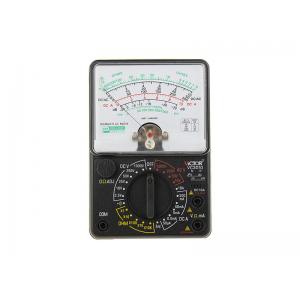Digital Pocket Analog Multimeter 10A 1000V With Resistance Function
VC3010 Analog Multimeter Large Lcd Display 1000V 10A 10kΩ
SAFETY INFORMATION
- Never use meter on the electric circuit that exceed 3kVA.
- Pay special attention when measuring the voltage of AC30 Vrms or DC 60V or more to avoid injury.
- Never apply an input signals exceeding the maximum rating input value.
- Never user meter for measuring line connected with equipment (i.e. motors) that generates induced or surge voltage since it may exceed the maximum allowable voltage.
- Never use meter if the meter or test leads are damaged or broken.
- To ensure safety and maintain accuracy, calibrate and check the meter at least once a year.
- Never use uncased meter
- Be sure to use a fuse of the specified rating or type. Never use a substitute of the fuse or never made a short circuit of the fuse.
- Always keep your fingers behind the finger guards on the probe when making measurements.
- Be sure to disconnect the test pins from the circuit when changing the function or range.
- Before starting measurement, make sure that the function and range are property set in accordance with the measurement.
- Never use meter with wet hands or in a damp environment.
- Never use test leads other than the specified test leads.
- Never open tester case except when replacing batteries or fuses. Do not attempt any alteration of original specifications.
SPECIFICATIONS
General Specification
| Item |
Specification |
| Circuit protection |
The circuit is protected by fuse even when voltage of up to AC 230V is impressed on each range for 5 seconds. |
| Internal battery |
R6 (IEC) or UM-3 1.5Vx2, 9V6F22. |
| Internal fuse |
0.5A/250V, Φ5.2mm X 20mm. |
|
Standard calibration temp
And humidity range
|
23±2℃ 45∽75% RH |
|
Operating temperature
And humidity range.
|
0∽40℃, 80%RH max. No condensation |
| Withstand voltage |
3kV AC(1min) between input terminal and case. |
| Dimensions and weight |
154x104x34mm 291g(include battery) |
| Accessories |
One copy of instruction manual, Test leads |
Measurement Range and Accuracy
| Function |
Full scale value |
Accuracy |
Remarks |
| DCV |
2.5/10/25/50/250
/1kV
|
±3%against
full scale
|
Input impedance
20kΩ/V
|
| ACV |
10/50/250/1kV |
±4% against
full scale
|
Input impedance
9kΩ/V
|
| DCA |
50μA
0.5/5/50/500mA
|
±3% against
full scale
|
*1
Voltage drop 0.1V
|
| 10A |
Voltage drop 0.13V |
| Ω |
x1/x10/x100/x1k
/x10k
|
±3%of arc |
Center value 20Ω |
| DB |
-10∽+22d
(for 10V AC)
∽+62dB
|
_____ |
Input impedance
9kΩ/V
|
| Beep |
|
|
|
| HFE |
0∽1000 |
|
|
*Not including the resistance of the fuse .
Preparation for Measurement
- Adjustment of meter zero position:
Turn the zero position adjuster so that the pointer may align right to the zero position.
- Range selection:
Select a range proper for the item to be measured set range selector knob according.
|
NOTE
When determining a measuring range, select such one for higher voltage then the value to be measured as well as where the pointer of a meter moves to a considerable extent.
However, select the maximum range and measure in case the extent of value to be measured can nor be predicted.
|
- Set the range selector knob to an appropriate DCV range.
- Apply the black test pin to the minus potential of measured circuit and the red test pin to the plus potential.
- Read the move of the pointer by DC/AC scale.
| Arc |
Range |
Multiple |
|
Arc |
Range |
Multiple |
| 1 |
X10k |
X10k |
|
4 |
DCV250V |
X1 |
| X1k |
X1k |
|
DCV25V |
X0.1 |
| X100 |
X100 |
|
DCV2.5V |
X0.01 |
| X10 |
X10 |
|
ACV250V |
X1 |
| X1 |
X1 |
|
5 |
DCA10A |
X1 |
| 2 |
DCV1000V |
X1 |
|
6 |
dB |
|
| DCV10V |
X1 |
|
ACV10V |
X1 |
| ACV1000V |
X1 |
|
ACV50V |
+14 |
| ACV10V |
X1 |
|
ACV250V |
+28 |
| 3 |
DCV50V |
X1 |
|
ACV1000V |
+40 |
| ACV50V |
X1 |
|
7 |
hFE |
X1 |
| DCA500mA |
X10 |
|
|
|
|
| DCA50mA |
X1 |
|
|
|
|
| DCA5mA |
X0.1 |
|
|
|
|
| DCA0,5mA |
X0.01 |
|
|
|
|
| DCA500μA |
X10 |
|
|
|
|
